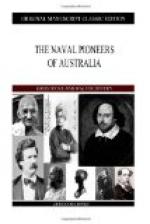In land exploring the military officers were not behindhand. Beside the work of the marines, a young Frenchman, Francis Louis Barrallier, an ensign of the New South Wales Corps, who came out with King, distinguished himself. King made him artillery and engineer officer, and he did much surveying with Grant in the Lady Nelson. Inland he went west until stopped by the Blue Mountains barrier; and King tells us an amusing story of this trip. Paterson, in command of the regiment, told King that he could not spare Barrallier for exploring purposes, so King, to get over the difficulty, appointed him his aide-de-camp, and then sent him on an “embassy to the King of the Mountains.”
Barrallier went home in 1804, and saw a great deal of service in various regiments, distinguishing himself in military engineering, among his works being the erection of Nelson’s column in Trafalgar Square. He died in London in 1853.
The Lady Nelson was a little brig of 60 tons burden, one of the first built with a centre-board, or sliding keels, as the idea was then termed. She was designed by Captain Schanck, one of the naval transport commissioners, and when she sailed from Portsmouth to begin her survey service in Australia, she was so deeply laden for her size that she had less than three feet of freeboard.
Lieutenant James Grant was, through the influence of [Sidenote: 1800] Banks, appointed to command this little vessel. He has much to say on the subject of sliding keels, for which see his Narrative of a Voyage of Discovery. The Lady Nelson was well built, and Grant showed his respect for her designer by his naming of Cape Schanck in Victoria and Mount Schanck in South Australia. In one of his letters to Banks, Grant says that, with all his stores of every description on board, he could take his vessel into seven feet of water, and could haul off a lee shore, by the use of sliding keels, “equal to any ship in the navy.” On the night of January 23rd, 1800, it blew such a gale in the Channel that six vessels went on shore, and several others were reported missing. This gale lasted for nine days, and during that time the Lady Nelson rode comfortably at her anchor in the Downs.
Grant’s instructions when he left England were to proceed through the newly discovered Bass’ Straits on his way, report himself at Sydney, and then set to work and survey the coast, beginning with the southern and south-western parts of it. The brig sailed, with a crew of seventeen all told, in February, 1800, and arrived on December 16th of the same year, being the first vessel to pass through Bass’ Straits on the way from England to Australia. On the voyage Grant discovered and named many points on the Victorian coast-line; then, as soon as the vessel arrived and received a thorough overhaul, she was sent to sea again to continue the work in company with a small intercolonial vessel, the Bee.




